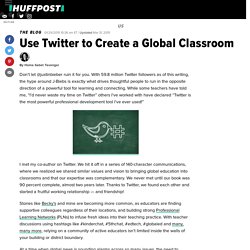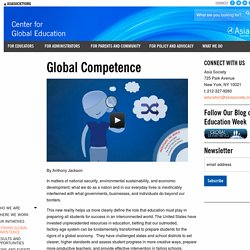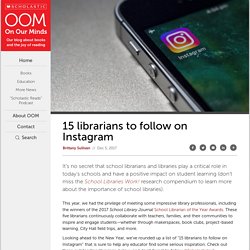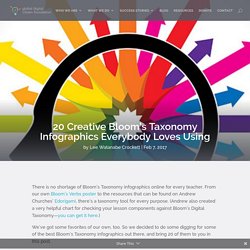

Kelsea
*Dealing With Digital Distraction in the Classroom.
Use Twitter to Create a Global Classroom. Don’t let @justinbieber ruin it for you.

With 59.8 million Twitter followers as of this writing, the hype around J-Biebs is exactly what drives thoughtful people to run in the opposite direction of a powerful tool for learning and connecting. While some teachers have told me, “I’d never waste my time on Twitter” others I’ve worked with have declared “Twitter is the most powerful professional development tool I’ve ever used!”
I met my co-author on Twitter. We hit it off in a series of 140-character communications, where we realized we shared similar values and vision to bringing global education into classrooms and that our expertise was complementary. We never met until our book was 90 percent complete, almost two years later. Stories like Becky’s and mine are becoming more common, as educators are finding supportive colleagues regardless of their locations, and building strong Professional Learning Networks (PLNs) to infuse fresh ideas into their teaching practice. 1.
Take Action To Step Outside Our Bubbles. Among the big lessons the U.S. election of 2016 taught the world, it’s that Americans don’t understand each other.

Polls and pundits hadn’t figured out what was under our noses all along: That we have been living in separate bubbles, with little or no experiential overlap. Within each bubble, one side is deemed ignorant, irrationally religious, or racist; while the “other side” is viewed as elitist, too soft, or morally lax. You know who you are - or who you aren’t. When we fail to get to know those who look, dress, speak, cook, worship, work, have fun, see the world, spend money or consume media differently than ourselves, it’s hard to build empathy for them. They become a statistic, a member of a confounding group, objectified. This isn’t how I want to raise my children. Small Steps Toward Empathy Make a Big Difference I’ve been researching the most effective means for thriving in a global economy and how to raise global citizens for almost two decades.
Start with stories. Center for Global Education (Please scan document) By Anthony Jackson In matters of national security, environmental sustainability, and economic development, what we do as a nation and in our everyday lives is inextricably intertwined with what governments, businesses, and individuals do beyond our borders.

This new reality helps us more clearly define the role that education must play in preparing all students for success in an interconnected world. The United States have invested unprecedented resources in education, betting that our outmoded, factory-age system can be fundamentally transformed to prepare students for the rigors of a global economy. They have challenged states and school districts to set clearer, higher standards and assess student progress in more creative ways, prepare more productive teachers, and provide effective intervention in failing schools. *Beyond the Bubble: Building Global Literacy in our Students KQ MayJun 2016. *Dr. V's argument. 15 librarians to follow on Instagram. It’s no secret that school librarians and libraries play a critical role in today’s schools and have a positive impact on student learning (don’t miss the School Libraries Work!

Research compendium to learn more about the importance of school libraries). This year, we had the privilege of meeting some impressive library professionals, including the winners of the 2017 School Library Journal School Librarian of the Year Awards. *Will Richardson - Personal Learning Networks. Week 2: Connected Learning, PLNs! (*=Key reading) *Overview of connectivism - Dr George Siemens.
*Will Richardson - Personal Learning Networks. *Connected Learning Principles. *Networked Student. *Examine What Makes a Literacy in the May/June Issue. A few years ago, at an ALA Annual Conference, I found myself experiencing a very peculiar day.

Besides my standard sessions on information literacy, I attended sessions on civic literacy and news literacy, as well. There were conversations in hallways about digital literacy, but also about disciplinary literacy and financial literacy. For some time I’d been following discussions of transliteracy–“the ability to read, write and interact across a range of platforms, tools and media from signing and orality through handwriting, print, TV, radio and film, to digital social networks” (Thomas 2007); this was a different use of the term “literacy” altogether, not focused on forms of media as much as on areas of knowledge. It started to feel a bit dizzying, and I wondered why all these different skills were being called literacies.
Are there any common characteristics that unite them in meaningful ways? Reference. 20 Creative Bloom's Taxonomy Infographics Everybody Loves Using. There is no shortage of Bloom’s Taxonomy infographics online for every teacher.

From our own Bloom’s Verbs poster to the resources that can be found on Andrew Churches’ Edorigami, there’s a taxonomy tool for every purpose. (Andrew also created a very helpful chart for checking your lesson components against Bloom’s Digital Taxonomy—you can get it here.) We’ve got some favorites of our own, too. So we decided to do some digging for some of the best Bloom’s Taxonomy infographics out there, and bring 20 of them to you in this post.
If you’re like us, you enjoy experiencing other creative viewpoints and sharing them with those that you feel may benefit from them. Future Librarians: Pro-Literacy & Everything in Between - EasyBib Blog. *7 Things That Happen When Students Own Their Learning.